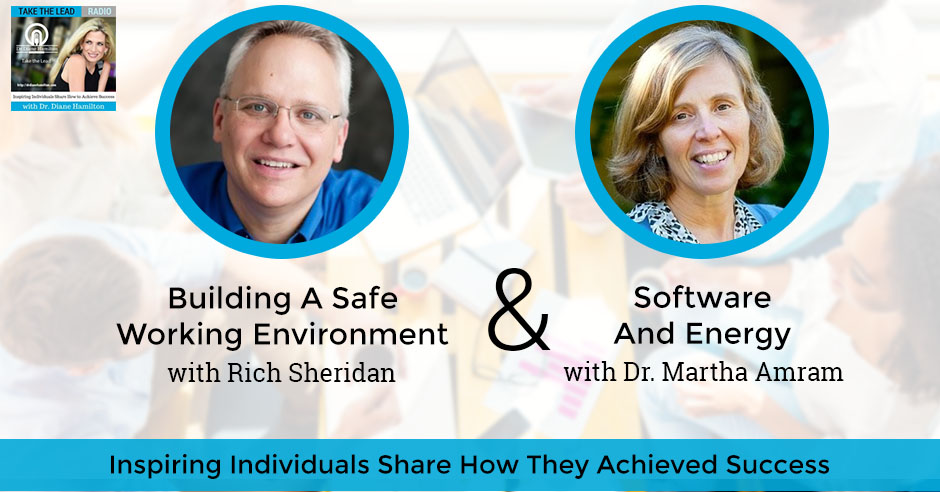
I’m so glad you joined us because we have Rich Sheridan and Dr. Martha Amram. Rich is the CEO and Chief Storyteller at Menlo Innovations. He’s the top author and so is Martha. She is a CEO and Founder at WattzOn. They both have great books and they have a very interesting background. We’re going to talk to them about what it’s like to be CEOs for their organization.
Listen to the podcast here
Building A Safe Working Environment with Rich Sheridan
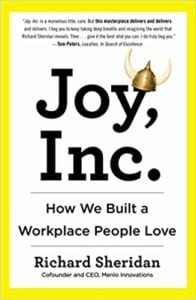
I am here with Rich Sheridan, who is the CEO, Chief Storyteller and Co-Founder of Menlo Innovations. Rich has gone from being a kid programmer in 1971 to Forbes cover story in 2003. He is the author of Joy, Inc. Our friend, Marcel, introduced us. Rich, welcome.
I’m excited to be here, Diane. Thanks for inviting me in your world.
I’m excited to talk about this because I’m a big fan of making things more fun. Jobs can be dull sometimes and people get burned out and I love that you focus on joy. Before we get into that, I want to know how did you get to the level that you are at? I know a little bit of your backstory, but maybe some of the people listening might not know it. Can you fill us in on your work history a little bit?
I started out writing software when I was a kid in high school back in 1971. I know a lot of people who are younger are amazed that there are computers back in those days, but there were. I thought I had discovered a career at that point, at that young age and for whatever reason I could see the future. It seemed like software was going to be important, probably I had no idea back then just how important it was going to be. I saw not only a future in the industry but a future for myself in that industry. I had a lot of fortunate twists and turns in my early life in those days and eventually, started working as a program. Even before I came up here to the University of Michigan to get a couple of degrees and launched a career in 1982 after graduating from Michigan, very quickly my chosen profession, the thing I was so excited about, felt like it was starting to betray me. I fell into pretty quickly a trough of disillusionment where I didn’t think I could last.
By my mid-30s I was getting a little desperate and I looked ahead for 25-ish years and said, “I don’t think I can make it.” I started digging my way out. The weird thing was I was very successful, the world was telling me I was doing a great job. It’s in my heart I knew I could do better. What I wanted to accomplish was this elusive career joy where what you’re producing makes a difference in the world. Quite frankly, the teams I was a part of later I was leading were far falling far short of what I thought was possible. My journey out led me to author some books but not on technology, rather books on leadership, management and creating culture.
By 1999, I made a dramatic shift over a couple of years period to a new way of working where I was a VP and it changed my life. It changed the lives of the people around me. I’d probably still be at that company were it not for the bubble bursting back in 2001. What I learned in those two years could be carried outside of the company I was at. We started Menlo Innovations with this very specific goal to end human suffering in the world as it relates to technology and return joy to technological efforts. That’s where I’ve been spending the last seventeen years of my life and even writing books about it and talking about it.
You have and you’re the author of Joy, Inc. I totally relate to a lot of what you said. I remember the cards were used for computers. Looking at how you talked about how you were all energized by the first time you put a two-line program into a Teletype and it came back with the words, “Hi, rich.” That was my thinking. I could remember the first time I even got on a typewriter was, “This is the coolest thing.” Then we came out with computers, “I thought that was the best thing ever.” I’ve worked around a lot of different people and I’ve studied personality. I write about curiosity and different things. I was thinking about how I’ve worked around programmers and introverts and how some of them don’t necessarily feel comfortable if you do things that are too peppy. How do you determine what’s joyful in an organization for everybody?
[bctt tweet=”Human beings are intrinsically wired to work together in community to serve others.” username=””]For us, our joyful purpose is externally focus. We arguably answer two important questions for ourselves as a company and as a team, who do we serve and what would delight look like for them? That becomes a central organizing force of our culture. I fundamentally believe that we, human beings, are intrinsically wired to work together in a community, to serve others. Technical teams’ joy doesn’t derive from football tables and ping pong tables and beer 30s. Those are all just band-aids over a broken culture. What they get joy out of is see the work of their hearts or hands and their minds get out into the world and delight the people that are intended to use it.
Everything we do here is laser beam focused, short, straight lines, back to that joy to delight the people we serve. They are the end users of the software we’re building here. We’re a custom software design development firm we’re typically building software for other businesses. Those businesses will then take that software and potentially deploy it or sell it out to the world. Eventually, somebody shows up at work and starts using the software we created. We will never meet them. They will never know who we are. They will have never paid us for what we do, but our goal is to delight them and we had to reorganize the entire process in order to make that possible.
How do you make it possible? It’s very fascinating to me, but some jobs make more of a difference than others. How do you help people realize how they’re making a difference? I would think about look at playing bricks as you’re laying bricks. You can look at it as you’re building this great building that’s going to save children’s lives or there are different perspectives. Is that how you do it?
There are a couple of big pieces here at Menlo that keep us in touch with the heartbeat of project we’re working on. The first piece is an invention of ours, not radically different from other things that go into the world, but probably radically different applied and integrated into a software team. It’s what we call high-tech anthropology. We have about a quarter of our team are what we call high-tech anthropologists. Their job is not to raise software, their job is to go out into the world and observe people without interruption in their native environment. Learn about them, learn their workflow, their vocabulary, their goals as human beings, and use that information to design the first pass at a user experience. Then take those first passes back out into the world and essentially test those designs against the people who will ultimately use them every day to see where did they stumble? Where do they make mistakes? Where do they get stuck? Where do they not understand?

Then essentially design those errors out of the system so that by the time the software work itself is complete, the end users look at the software and they’re like, “It works like this. How else could it work? It’s obvious.” The one big piece is this idea that you need a different team, not the technical people, but the people who are going to deal with what I call the icky human squishy stuff. The stuff that doesn’t fall neatly into ones and zeros buckets. Then use the information gathered to craft the experience and then have a software team bringing that experience to life in software. Then along the way, iteratively and incrementally demonstrate the work to our customers. The people are paying us to do the work. We demonstrate our work once a week with each of our customers in an event we call show and tell.
You’re reconnecting the people doing the work, building that cathedral with the people who are going to take their families there to worship because the software is very theoretical until you can touch it. We are early on putting the software in the hands of the people we’re serving directly through our paying customers and also out into the world of people who will one day use this. That energizes the team because if you’re working on a three-year-long project every week you’re getting a little bit of feedback in how are you doing. Are you getting to the goal? Are you doing things people care about? That iterative and incremental energy that comes from seeing that people care about your work. They care about what you’re doing. Too often programmers in many software teams languished for years, not having any clue whether the work they’re doing will ever see the light of day. If it does, whether anybody would want to use it.
I’ve worked for a company where we created software for schools in the early ’80s. I can remember they were put in a back room somewhere. I’d only programmed in basic. It’s been a long time. I had programmed my calculus homework in college in basic. I remember them being in these long, big rooms full of programmers and no one talked to anybody. It was depressing in the day.
We take introvert in his years, put them in sensory deprivation chambers, cut them off from all other human interactions, let them put headphones over their ears, but later lament they lack interpersonal skills. I want to speak up for the introverts because our team is filled with them. This is an industry that thrives with introverts. We couldn’t function without our introverts. What we have discovered over time is that introverts don’t prefer sensory deprivation, what they prefer are fewer, safer, deeper relationships with other people. In that safe environment where it’s not chitchat and social hour all the time, they can get real work done.
[bctt tweet=”This is an industry that thrives with introverts.” username=””]Susan Cain‘s book did a lot to shed a good light on that. The value of introverts have in the workplace is huge. It’s a great book that she wrote and she’s been very popular. I’m looking at all these awards that you’ve won and you’ve been invited to the White House. You do all these speaking engagements. The list goes on and on. Tell me about the White House.
There were a couple of times I got there. One was in counseling women and girls and they wanted to make sure that part of the workforce is being engaged and we have a lot of strong practices here that it could be very inviting to have a good gender mix and from typical tech firms are so skewed towards the male side of the equation. We’re not quite 50/50, but pretty close to 50/50 between men and women here. We’ve gotten a lot of attention for some of the things we do to make it easier for women to work at Menlo and that got me one of the invites.
It’s tough sometimes in the technology to get as many women involved, so 50/50 is pretty amazing. In addition to your awards, I love how you consider yourself a chief storyteller. I want to know what you mean by that and why that name?
It was a playful title at first. We do a lot of tours here at Menlo. Between 3,000 and 4,000 people a year come from all over the world just to see how we do what we do. They come literally from all over the planet. They come, they stay a couple of hours, a couple of days or maybe a full week and they study us. They want to learn from us, they want to hear from us. In the early days, we were doing those tours and I led most of them. I’ve found that the best way to communicate a lot of what we do here is through stories of things we’ve done in the past that evoke the ideas, the emotion, the success or the lack thereof of the things we’ve tried. After a certain point, because the tours are done right in our space around our team, the team started hearing all my stories. They started calling me chief storyteller and I thought, “That’s a clever name. Eventually, I playfully started putting it on my business card. It’s on there officially now.”
Then it dawned on me as I was talking with the team about the impact on them of the stories I was sharing with the world because they would start to tell me, “Rich, when you give these tours and you tell maybe some of the same stories over and over again, I want to stop and listen.” It started to dawn on me that the idea of storytelling is probably one of the most important ideas to capture our history in a way that’s consumable and repeatable that can provide a long arc of understanding of what you’re trying to accomplish. You start to think back in human history, totems and campfire, stories and anthems. How does a community, a tribe or a nation capture their history and how do they propel it forward?
I realize that storytelling is a tool as old as human history. We are wired as humans for authenticity seeking. It’s probably one of our finest senses of smell, is the person who’s telling the story authentic? Do I believe them? When you can get to authentic storytelling, which means you’re going to tell good stories and bad, then reveal the things that are working and the things that aren’t working rather than just crafting a story that’s Pollyanna-ish on one side because you’re forgetting the negative history of things. You can steeply see the culture. Leaders that are getting engaged in followership are often very good storytellers.
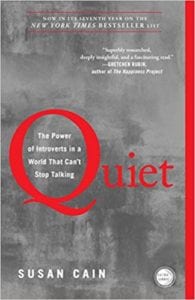
I’ve seen some of your videos and I could see why they would give you a title, you’re good at that. You also were featured on the cover of Forbes Magazine in 2003, which is quite an accomplishment to cover at Forbes. I’m curious what led to them putting you on the cover and what was that experience like?
Number one, it’s hilarious to get on the cover of the national magazine because your friends start sending you pictures from all over the world saying, “Rich, I’m in the Honolulu Airport and I’m looking at you on this magazine.” I happened to be in New York City when the magazine was out. I was in Grand Central Station. I saw a pile of the magazines. I picked up twenty of them, put them on the counter, and she looked at me funny like, “Why do you want to buy twenty copies of the same magazine?” I held it up next to me. She goes, “The guy in the cover,” and she says, “Take ten more.” I thought that was so kind until she charged me for all 30 of them. That made sense to me. She knew a sale when she saw it.
The story itself came through what I would call a bolt of lightning serendipity. We had been doing tours for a while and a lot of people in Ann Arbor knew my story personally of how I lost my job in the internet bubble burst and how we decided to start a company. This Forbes article, Emily Lambert was the author of the article, her boss told her, “Go interview an older tech entrepreneur who decided after he lost their job in the bubble burst to start a company rather than finding another job.” She called me out of the blue and I said, “Emily, how on Earth did you find me? There has to be 100,000 out there.” She said, “I didn’t know how to find one of you, so I called my alma mater,” which happened to be the University of Michigan. I asked, “Do you know anybody like this?” A lot of people know me in Ann Arbor, so they pointed her to me and the rest is history. My encouragement to entrepreneurs out there is when the phone rings, answer it. When I saw Forbes Inc. on the caller ID, I was ready to hang up on them because I figured they were trying to sell me a subscription.
I’ve worked with Steve Forbes and at the Forbes School of Business. Every once in a while, I go to Forbes Summit. They had the Women’s Forbes Summit where they have the blank back of the magazine and they take a picture of you like you’re on Forbes Magazine as part of the summit. Everybody wants to have this fake picture. I can’t even imagine what it’s like to have the real picture because that’s impressive. You could see why you would have caught their attention. What you’ve done is fascinating. I want to hear more about the book, Joy, Inc. What will we learn from that?
The world pushed me into the book writing business even though I went there delightfully because I love to write. We have been sharing these stories in so many different ways. Me personally, through keynote speeches I’ve been doing around the world. Suddenly, people were hearing us and saying, “You have to write a book about this.” What we wanted to do was give people an honest look inside of a real working company, not to tell them you should be like us, not to tell them you should copy us or that we found the one true way.
A lot of times when you either read books or articles, go to conferences or talk with a variety of experts on subjects. Every once in a while, somebody probably has that temptation to say, “A real-world example right about now would be helpful.” We told the story of what we had created Menlo, why we created it the way we did, how it all works, all the pieces and parts, where we struggle, where we succeed and why we did it that way. It changed my life. I’ve been on sitting on airplanes all the time now.
I can understand that one. It’s challenging to not only have a culture of joy but in the research I’ve done, I’m trying to get people to be more curious, which could lead to more engagement, more joy, more other factors. Do you have any tips on creating a culture of curiosity to lead to more innovative ideas and more engagement and that type of thing?
There’s a second book that’s titled Chief Joy Officer and the subtitle is How Great Leaders Elevate Human Energy and Eliminate Fear. Those two pieces, the human energy and the fear are interesting as it’s related to your question. When I think of what does an organization need and what is being demanded of organizations, I will simply say what we need more than anything else is the best part of humanity we can bring to the table. If we think about humans, it’s the most basic biological level. What’s the part of our brain that makes us the most human? It’s the same part of our brain that captures creativity, imagination, innovation, venturing and curiosity. What shuts down that part of our brain? Fear, adrenaline, and cortisol.
[bctt tweet=”Introverts don’t prefer sensory deprivation. What they prefer are fewer, safer, deeper relationships with other people. ” username=””]Once you put a couple of drops of those in the bloodstream, it shuts down that big oxygen-consuming part of our brain and pumps all of our blood out to the extremities so we can go into fight or flight mode. Our formula is relatively straightforward in the sense that we want to make sure people feel safe here. If they feel safe long enough, they will begin to trust one another. If you get trust going long enough, you’ll start to get collaboration. To get collaboration, you’ll start to get that high energy human teamwork. If you stay in that spot long enough without disturbing it too often, you’ll get to creativity, energy, invention and imagination. That’s where every company on the planet wants to be, needs to be, has to be. Yet if we’re running our teams with the same draconian, sarcastic fear-based methods and tiring them out, burning them out, we’ll never get that. We’ll just be frustrated with ourselves as leaders.
You made so many important points there and it goes along with what I found in the research. The four things that keep people from being curious are often fear, assumptions that they’re not going to like something or that it feels hard or assumptions in general. Technology sometimes doing things for them or being fearful of it they overlap and then environment. You’re touching on all those things. With the advent of so much technology that’s replacing jobs and eliminating the need for certain talent, people need to open up their minds to some maybe new possibilities, internet bubble burst. I love that you’re opening up people’s minds to eliminate that fear. So many people can learn from that. Thank you for sharing that. Is there anything else?
The other thing that’s very common here that can fuel this human energy of a team is to move to action orientation versus contemplation orientation. A contemplation is, “That’s a great idea. Let’s have a meeting about it. Let’s consider forming a committee. Let’s write a policy rather than action.” Here at Menlo, one of our most common phrases, which is that the root of curiosity is, “Let’s run the experiment.” Somebody comes up with a new idea rather than kill it in the instance, “We’ve tried that one or I’ve thought about that, but I don’t think will work,” which often kills new ideas on the spot. Our team is like, “I know, but let’s try it. Let’s run the experiment. Let’s see what happens.” It doesn’t always go the way you thought. It would probably almost never go the way you thought it would, but in that process, you discover things you never would have expected.
That’s important because we do make assumptions that things are not going to work or it’s not worth the effort or all those things you were saying. It sounds like we have a lot of things that we like to study that are in common so I can see why Marcel introduced us. I enjoyed having you on the show. Many people would like to know how they could buy your book and find out more about your company. Do you have a website or something you’d like to share?
They can come visit us on our website, named after the Menlo Park, New Jersey lab of Thomas Edison. Visit MenloInnovations.com. They can follow me on Twitter and LinkedIn, @Menloprez and they can come visit. We love having visitors if they’re interested. We hit a couple of guys here from Poland in Latvia and they spent an entire week with us so it’s not uncommon. Please come see us. We’d love to share our story with you and what we’ve learned and learn from you.
Thank you, Rich. This was insightful and I enjoyed speaking with you. Thank you for being on the show.
Thank you.
Software And Energy with Dr. Martha Amram
I am here with Martha Amram, who is the Founder and CEO of WattzOn. As a respected leader in energy and economics, she founded WattzOn to help the massive and undeserved residential energy efficiency market. Martha, I’m looking at your background and you have a degree in mathematics. You’ve got a PhD in applied economics from MIT. Welcome to the show.
Thank you so much for having me.
How do you get a PhD in economics and in math? You have a beautiful mind.
There’s nothing like going to MIT to make you feel very humble and mortal. There are a lot of smart cookies there and clearly, I did find in life that there are brainiacs, but there are others.
[bctt tweet=”Storytelling is probably one of the most important ideas to capture history in a consumable and repeatable way.” username=””]It’s an impressive background and that’s never been my best topic to deal with, which is math. I was great when it was Algebra and when we started statistics that got rough, but I got better as I got older. It has been a big part of my research. I worked on this assessment to determine the factors that hold people back from being curious. I’m curious if you’ve always been curious or is this something that you had to work on?
I am a very curious person. It’s a combination of curiosity and that math and economics training gave me a framework. I can pull things together and start seeing the future. I get curious as to how can I make that happen? What can I do? I’m an activist in that sense. I’m always looking for the angle, the corner to turn into that future. I’m very motivated by that.
You’ve written several books and it does take a motivation to write books. You wrote Value Sweep, case studies and corporate finance. Did I get all your books? I want to make sure I have them on here.
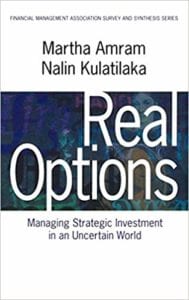
I’m most known for a book I wrote with a great friend, Nalin Kulatilaka. He was a classmate at MIT with me and we both were on the faculty at Boston University at one point. That book is called Real Options. It’s the application of the mathematical formulas underlying financial options, the Black–Scholes equation. Taking that whole structure and applying it to real assets, non-financial assets, oil wells, pharmaceutical drug discovery, R&D projects, hence its name, Real Options. It was applied and still is used by companies who have ‘if, then’ problems, “If I did this and then it worked out, what would happen next? How could I value that asset if I did this and it worked out, then what happened?”
I’m dealing with a lot of what’s going to happen with innovation, wiping out jobs. We dealt with a little bit of that in the research for curiosity. If you develop curiosity, you will get people more creative. They are more engaged, they’re more productive. They won’t go down, “If you create a fix this, you fix that.” What do you think is going to happen? How do you deal at all with what’s going to happen with all the artificial intelligence and all the jobs being impacted? Do you do any analysis in that respect in your If-then thinking?
I’m a reader of that analysis and my company, WattzOn, is in the energy business and we’re a software company. What we do is help a solar company, smart home providers and other companies that need utility bill data. We help them get that data and then we help read it. When we read it, it’s not human, it’s artificial intelligence at this point. Thus, we’ve become quite good at machine learning and artificial intelligence. We are in discussions with customers who have 600 people employed doing data entry that we would automate and reduce. I’m very much aware of the role of this displacement technology. It’s sold as speed a human because it’s automation-assisted, but when you speed humans, you can grow market and open up the things that price goes down and cost goes down, but you also reduce human involvement in that process. You literally cut out jobs.
That’s what I wanted to develop a way for people to change their skill sets. Maybe they’ve always done this. We always thought when computers came out in the ’80s and I remember when I was selling computers, everybody was complaining. They’re going to lose their jobs and they did, but there were other jobs created. Now we’re seeing it even more so with what’s going to happen. It’s a fascinating area of study of what we’re going to do to get people more aligned with better jobs.
One thing that’s different this time and I’ve talked to a lot of economists about it. You’re right because technology is a compliment to human productivity, it makes us better. We can do things better. That’s it. So far in human history, it’s been creating more jobs and creating more wealth. The difference this time is that artificial intelligence is disruptively better. It’s not incrementally better, it’s hugely better. We can go into a market and cut out 80% of the cost. When you can do that, then you have market power. That changes the economics of industries because those who adopt and deploy artificial intelligence in a way that disruptively lowers costs or makes customers stickier disruptively, they gained much market advantage so fast. Then you’ve cut jobs but you haven’t found the next best thing. You have this period of unemployment.
How long is that period?
Unfortunately, I don’t know.
Andrew Yang is running for President in 2020. I don’t know if you’ve seen his platform. He’s trying to give everybody a $1,000 a month so that they can get re-educated and find new skills. If they’re displaced that they have something to develop them. It’s an interesting thing from an economics perspective. What happens if you give somebody $1,000 a month? Does that change? Does that solve the problem? Do you think they’ll get jobs and educate themselves based on that?
I’m on the board of a non-profit growth sector, which is tackling this problem. The premise behind growth sector is community colleges are a vastly underused resource. When young students start a major in community college with the intent to transfer into a four-year school to do engineering, math or any science technology related curriculum, the transition rate is 3%. The growth sector provides a program that takes a high school graduate, puts them under a heavy-duty mentorship and catch up program for a year to beef up their math skills and study skills. Then they matriculate into community college and then go on to four-year schools and their rate of matriculation to four-year schools is 67%. The $1,000 a month if I take their program costs that’d be a little light. You’d need a little more than a $1,000 because you need to live.
They’ll say that’s a $1,000 a month at least. You would need to pay for the program, but it’s not much more than let’s say $5,000 a month per student. It lasts for a year and then this program growth sector also provides internships at related careers like NASA and PG&E and other sectors that are going to use these skills so that the students get job-related skills on the job. That combination is successful. You don’t need to give someone $1,000 for life. Let’s say you give them a booster shot and there’s proven programs like this that works.
[bctt tweet=”Fear keeps people from being curious.” username=””]I thought it was interesting that he was giving everybody. You and I would get it as well. I wonder if you could give more to different people. He was focusing on some of the things and you focused on some of the things. I’ve talked to Gerald Chertavian from Europe who was on my show. They do something similar for underprivileged areas. They go and give them a year of training to get them up to speed, to be able to go interview and get jobs, go to school and get what you’re talking about. Those same skills. It’s a shame that we’re not getting them anyway in high school. Why aren’t we? What can we do to change this? Do you see this as a problem?
We’ve been so stretched in California with budgets and we have so many high schools that are not serving our students very well. That shows up in national rankings, shows up in their ability to complete courses at community college and to better themselves. They don’t have the basic skill sets, we do have an issue. I want to turn to another reason of why it’s hard to make that transition. We’re in the energy business and it turns out that utility bill payments, your history of paying those bills on time can be transferred to the credit bureaus and then folded into your credit score.
For people who don’t have auto loans or mortgages, this monthly payment and great payment record can boost their FICO score about 30 points. Even though I’m on energy, I’ve been to a lot of consumer credit conferences. In that network, there is an interesting study called financial diaries that shows a working-class family, the candidate for this type of credit score improvement, and the struggles they face.

It’s a couple of different things. One is two people working part-time jobs, a combination of full-time jobs, trying to supplement their income. Some months they might make $3,000. Other months they might make $750. It goes up and down. They have huge income volatility. They don’t have income security, they’re working their butts off. When the car brakes, then it’s a total financial disaster. For example, if you look at why young men drop out of community college, it’s their car broke. They can’t get there anymore. They have to go get a second job to pay for the new car because if you’ve taken out a used car loan, you still have to pay the loan even though the car broke. Until you might be paying off the old one while you’re trying to get the new one hence it’s hard given the volatility uncertainty of day-to-day life and the lack of savings and credit to focus on your education.
It is tough and I’ve taught more than a thousand online business courses in my history of teaching. I’ve seen a change in how they’ve been created, how popular they become and the value they add. Some people look at them in a negative light because of some of the schools in those situations. In some of the major universities now have online programs. What do you think of online education?
In the MIT circles, I went to an MIT alumni cocktail party and there was a guy who had sold a robotic stuff into Google beefing up his credentials and artificial intelligence through online courses. You would think that guy could have access to any university, any place and he found through a little bit of smoothing on his own that the online curriculum taught by Andrew Ng and others was far better than he could get in person. It’s that power to leverage the brilliant teachers. This guy could do essentially a week of courses as a day and he was powering through it. You could make a real difference in your life with online education. MIT has an open courseware where anybody can go look at their stuff and use it. You can take a test at the end and they’ve admitted students from far-flung places based on their good performance in these online courses.
I went to visit MIT when I was in Boston. It was so cool going there. It has this rich old feel to it. You feel like you’re in the heart of the genius. I’m going back to Boston and I was thinking next time I want to go see Harvard. It must have been fun to go to school in that area.
You’ve got Boston College and Tufts, Northeastern and Boston University. It’s a wonderful college environment, a mecca for college kids.
It’s definitely given you a strong background. You do a lot of speaking on valuation and growth strategy. Is that your main focus?
My main focus is running our software company, WattzOn, and serving our customers in the energy markets. I was a college professor, which gave me the brutal learn how to do public speaking training. Then I wrote the books. I have been on those tours and done those corporate conversations and so on. Now I use them strategically to advance our company’s goals.
What’s coming up new, different from your company? Anything you can chat about?
We help people with utility bill data and we see a very large market for this in the consumer credit markets. In other markets where you want the whole analysis of a building, it’s energy, water, waste use, we can get all that, build data and read it. It’s had a lot of incoming calls about that processing that we can do and does it work for healthcare records? Yes, it does. Does it work for environmental permits? Yes, it does, and accounting forms and so on. We’re breaking our company into two business divisions. WattzOn will continue to use our full suite of technologies and serve the energy and credit markets. Then we’re forming a new business unit, Glynt.Ai, which we’ll use all of our AI technology and serve customers outside the energy market. We’re finding a huge customer traction in both areas, so it’s a pretty busy time for us.
You were the CEO of Vocomo. Is that a voice software company?
Yes, it played a role in the interface between the car driver and passengers and at that point, whatever was before the Cloud that now we would call the Cloud. There was a company called General Magic that did this as well. If you wanted to get driver assistance or roads or directions, you would press a button on your visor or your mirror up there and start talking and say, “Vocomo, how do I get to or give me the latest information on the traffic.” Then a voice application would come back and read you the information. At that time in the late ’90s, the industry thinking is it would be tied to the car and the car would be a walking computer and be as important to you as a cellphone. The cell phone introduction meant that the cell phone with you and thus the car became a holder of it. At the time of the voice software at that time it was thought that the car was the center of all of this.
[bctt tweet=”Technology is a complement to human productivity.” username=””]You’ve done so many interesting things. There’s so much focus on women in technology that we’re not getting enough women interested in tech. You have been very successful. Why do you think you became interested where other women are not getting in as many as they’d like?
I started out as a math major and I’d be one of eight women in a 60-person class. I was the first woman to graduate in the applied economics department at MIT. There weren’t any women in finance or economics then. I’d been in all of those situations and for much of my career, I’ve been the only woman in the room, certainly the only senior manager who’s a woman. I persevered. I was on a panel and a young woman who is doing a startup said, “It’s so frustrating because we have a very solid business plan and I see guys getting funded so quickly. I could tell you ten reasons why their plan is a dud and they go out of business in fifteen months. I’m still here but I can’t get funded.”
She figured out an alternate way to get funded. She solved that problem, but she had to work ten times harder. I thought, “I’ve seen that in energy. I’ve seen guys get funded with dud plants and we’re still here.” At this point, because I’m at an older stage of my career, I have a résumé that I can get the meeting. I have the gravitas and my personal situation is different, but when I heard what that young woman was saying, I realized it’s still very pervasive. At this point, I do speak out more about it and I have far less patience with, “This is the way the world is. Take it or leave it.” The answers are you’ve got to persevere and have grit.
It’s not easy to do startups no matter what your gender. You also need a technical background. It’s not a forgiving place. If you don’t know how to manage a software team and you’re in the software business and you think, “I’ll be the consumer person. This other person, this software.” You don’t know enough about soccer, your team’s going to wander off and do the wrong thing. It has to be a solution that starts in high school to get women ready for college. In college, create opportunities for them to experiment and try things.
Then you’ve got post-college which is great, but then we’ve got the challenge of incorporating work-life balance. I’ve given talks and I will say to people, “Every person who is in charge of their kids, whether they’re in daycare during the day or you have a nanny or they’re in school, you’re still the primary parent in charge of your kid. It’s hard work and you’re going to probably need to park yourself at a job like for a couple of years. You don’t work your butt off and be the first one to get the promotion. You show up, do a fine job, and leave.” That’s okay. That’s not like gleaning in, that’s the antithesis. I’ve had women come up in tears and give me a hug and say, “Thank God, I need to take the pressure off myself. I can’t have a career and do all this family logistic stuff.” We need to check in and out of our career as we move through that system. You have to start from the beginning with a broad set of skills that will make you successful in a technical environment.

It’s interesting to see the level of how many women are in the software industry. It’s one of the first things I did. I used to sell system with 36, 38 software in the ’80s and I tended to be interested in STEM skills. I go to all these conferences. One of the things I hear so much is that even if you have STEM skills that people are lacking soft skills. You get the hard skills, then you don’t have the soft skills and it can be challenging. Do you find many issues with people lacking soft skills?
You can definitely hire a prop where people that would prefer to sit in the corner and face the wall. They would be a great solo siloed performer. Modern technology mediates that well. One of the technologies we use is Slack. I don’t know if you’ve used that and seen that. You can set up a channel and then people can do a group, can do a threaded chat in that channel. It’s searchable so you could provide “This report came in and this was the status system.” You can post that there and everybody can see it. Someone could comment on it and say, “I see that bug.” You can go back and see that later and make sure everything got fixed and so on.
[bctt tweet=”It’s not easy to start start-ups no matter what. You have to persevere and have grit. ” username=””]It gives you history and so on, but it mediates. You can have a distributed team, but it’s a cool interface. Even that person that would prefer to face the wall feels comfortable typing and stuff in Slack. The soft skills for getting your job done can be helped by technology in this way. Slack is not used just for software but for many teams. We use it to coordinate with customers and we’re dealing with product managers, customer success people and so on because it’s a useful thing. We can help ourselves with those technologies. In terms of providing technical leadership or company leadership, you have to have those, you have to have the strength to make tough decisions and you have to have the empathy to keep your listening hat always on. I’m not sure how you train for that.
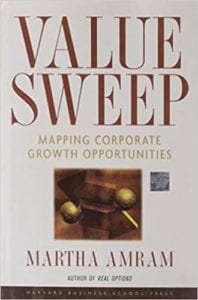
My dissertation was on emotional intelligence so that’s stuff that I deal with. I find that as a great response. Empathy is a big part of emotional intelligence and then with a lot of training is available for companies to do that. It’s so important and that led to my interest because of getting right in my dissertation on emotional intelligence. I started looking at personality assessments, which led to my interest in eventually writing this assessment on curiosity. Is there any software that you use to develop curiosity? They seem to know a lot of different software platforms. How do you develop curiosity in your workers?
We preselected and I’ll give you the story of two of my favorite developers. One came to us as a WordPress consultant to help us fix up our site. WordPress is not software development. It’s using a pretty nice configurable tool. The other guy is a former rock and roll musician who had an interest in the environment. He was a college graduate and he did his passion for a couple of years and after eating a lot of peanut butter sandwiches said, “I need a real job.” We have trained both of those to be very good software coders and we put them through a mentoring program.
We pay them to do work and we increased the complexity of work. What made that whole thing fit together is they were motivated and they kept reading on the lunch break on the evening break. They would read one or two things a day and keep investing in themselves. I don’t know if it was curious or if curiosity help motivates them to go find things to read and say, “I need to figure this out.” That self-motivation allowed them to bootstrap into software coding. That’s how we hire now. We look for people who are willing to take a little time out of their day every day to make themselves better at their profession. With that in hand, we’ll hire people who don’t have the particular technical skills and say, “That’s fine, we’ll teach you.” We’re not changing people we’re selecting on that criteria.
I’ve taken tests to get into companies based on how I saw myself. It’s important to self-assess and see how you’re coming across in the interview. We are looking for motivated people and I’d like to see more of that if we’re back to high school, we need to teach them more. What you’ve done has been impressive with all your successes with all your companies. I could see why Luke Hohmann suggested you for the show and anybody listening, you’ve got to give us credit. We did this on the fly, we’re not as prepared as usual. We finally got to meet and this was a nice chance to discover more of what you’re doing. It’s nice of you to be on the show and I’d love it if you could share how people can find out maybe more about your company and your books and how they can reach you if they’re interested.
You can find my books by Googling my name on Amazon or any of the normal places you buy books. They’re there and they’re still in print. There are a few of them. My company is WattzOn.com. That’s a great place to get started. We’ve divided into two and the second division is Glynt.Ai. Check it out.
Thank you so much, Martha. This has been so much fun.
Thank you. I appreciate it.
Your welcome. I want to thank Rich and Martha. This has been fascinating and it’s always great to see things from the CEO perspective. We get a lot of CEOs on the show. If you’ve missed any of the past episodes, you can go to DrDianeHamiltonRadio.com. I hope you check that out and I hope you join us in the next episode.
Important Links:
- Menlo Innovations
- Joy, Inc.
- Susan Cain
- Forbes article
- Chief Joy Officer
- MenloInnovations.com
- @Menloprez on Twitter
- WattzOn
- Value Sweep
- Real Options
- Andrew Yang
- Gerald Chertavian
- Glynt.Ai
- Slack
- WattzOn.com
About Richard Sheridan

Richard Sheridan is the CEO, Chief Storyteller and Co-Founder of Menlo Innovations. Rich has gone from being a kid programmer in 1971 to Forbes cover story in 2003. He is the author of Joy, Inc. Rich has never shied from challenges, opportunities nor the limelight. While his focus has always been around technology, his passion is actually process, teamwork and organizational design, with one inordinately popular goal: the Business Value of Joy! Sheridan is an avid reader and historian, and his software design and development team at Menlo Innovations didn’t invent a new culture, but copied an old one … Edison’s Menlo Park New Jersey lab. Henry Ford’s recreation of the Menlo Park Lab in Greenfield Village was a childhood inspiration!
About Dr. Martha Amram
 Martha Amram is the Founder & CEO of Wattzon. As a respected leader in energy and economics, Martha founded WattzOn to help the massive and greatly underserved residential energy efficiency market. Martha was CEO of Vocomo Software, a voice software company, Chief Economist of PLX Systems, a patent and copyright software company, and co-founder of Glaze Creek Partners, a consulting firm she sold to Navigant Consulting (NYSE: NCI). Martha is the co-author of two books published by the Harvard Business School Press (Value Sweep and Real Options), and a third book published by McGraw-Hill. Martha is a frequent speaker on residential energy efficiency and business strategy. She is a Senior Fellow of the Milken Institute, where she has written reports on financial innovations in the biotech and cleantech industries. Martha holds a PhD in Applied Economics from MIT’s Sloan School of Management.
Martha Amram is the Founder & CEO of Wattzon. As a respected leader in energy and economics, Martha founded WattzOn to help the massive and greatly underserved residential energy efficiency market. Martha was CEO of Vocomo Software, a voice software company, Chief Economist of PLX Systems, a patent and copyright software company, and co-founder of Glaze Creek Partners, a consulting firm she sold to Navigant Consulting (NYSE: NCI). Martha is the co-author of two books published by the Harvard Business School Press (Value Sweep and Real Options), and a third book published by McGraw-Hill. Martha is a frequent speaker on residential energy efficiency and business strategy. She is a Senior Fellow of the Milken Institute, where she has written reports on financial innovations in the biotech and cleantech industries. Martha holds a PhD in Applied Economics from MIT’s Sloan School of Management.